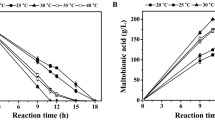Abstract
Pseudomonas taetrolens has previously been shown to convert cellobiose to cellobionic acid (CBA), which can potentially be used in cosmetics, food, and pharmaceutical industries. The cellobiose-oxidizing activity of the P. taetrolens strain, which expressed the homologous quinoprotein glucose dehydrogenase (GDH), was increased by approximately 50.8% compared to the original strain. Whole-cell biocatalyst (WCB) of the genetically modified P. taetrolens strain [pDSK-GDH] was prepared simply by fermentation and washing processes. Reaction conditions for the proper use of WCB, such as reaction temperature, cell density to be added, and cell harvest time for preparing WCB, were investigated. The highest CBA productivity (18.2 g/L/h) was achieved when WCB prepared in the late-exponential phase of cell culture was used at 35 °C with cell density of 10 at OD600nm. Under these conditions, 200 g/L of cellobiose was all converted to CBA in 11 h, and the WCB of P. taetrolens [pDSK-GDH] maintained the maximum catalytic activity during at least six cycles without a significant decline in the productivity. Our results suggest that the manufacture of WCB based on genetically engineered P. taetrolens and its optimized use could be further developed as an economically viable option for the large-scale production of CBA.





Similar content being viewed by others
Abbreviations
- CBA:
-
Cellobionic acid
- GDH:
-
Quinoprotein glucose dehydrogenase
- WCBs:
-
Whole-cell biocatalysts
References
Kiryu T et al (2015) Lactobionic and cellobionic acid production profiles of the resting cells of acetic acid bacteria. Biosci Biotechnol Biochem 79(10):1712–1718
Hildebrand A et al (2015) Engineering Neurospora crassa for improved cellobiose and cellobionate production. Appl Environ Microbiol 81(2):597–603
Oh Y-R, Eom GT (2021) Identification of a lactose-oxidizing enzyme in Escherichia coli and improvement of lactobionic acid production by recombinant expression of a quinoprotein glucose dehydrogenase from Pseudomonas taetrolens. Enzym Microb Technol 148:109828
Desai SH et al (2015) Isobutanol production from cellobionic acid in Escherichia coli. Microb Cell Fact 14(1):52
Kiryu T et al (2019) Identifying membrane-bound quinoprotein glucose dehydrogenase from acetic acid bacteria that produce lactobionic and cellobionic acids. Biosci Biotechnol Biochem 83(6):1171–1179
Mao S et al (2018) Efficient production of sugar-derived aldonic acids by Pseudomonas fragi TCCC11892. RSC Adv 8(70):39897–39901
Alonso S, Rendueles M, Díaz M (2013) Bio-production of lactobionic acid: current status, applications and future prospects. Biotechnol Adv 31(8):1275–1291
Kim J-H et al (2020) High-level production and high-yield recovery of lactobionic acid by the control of pH and temperature in fermentation of Pseudomonas taetrolens. Bioprocess Biosyst Eng 43(5):937–944
Oh YR et al (2020) Enhancement of lactobionic acid productivity by homologous expression of quinoprotein glucose dehydrogenase in Pseudomonas taetrolens. J Agric Food Chem 68(44):12336–12344
Oh Y-R, Eom GT (2022) Efficient production of cellobionic acid from cellobiose by genetically modified Pseudomonas taetrolens. Biochem Eng J 178:108282
Lin B, Tao Y (2017) Whole-cell biocatalysts by design. Microb Cell Fact 16(1):106
Leong YK et al (2020) High-level l-lysine bioconversion into cadaverine with enhanced productivity using engineered Escherichia coli whole-cell biocatalyst. Biochem Eng J 157:107547
Heyland J et al (2010) Simple enzymatic procedure for L-carnosine synthesis: whole-cell biocatalysis and efficient biocatalyst recycling. Microb Biotechnol 3(1):74–83
Gao H et al (2015) Repeated production of l-xylulose by an immobilized whole-cell biocatalyst harboring l-arabinitol dehydrogenase coupled with an NAD+ regeneration system. Biochem Eng J 96:23–28
Oh Y-R et al (2020) Efficient production of lactobionic acid using genetically engineered Pseudomonas taetrolens as a whole-cell biocatalyst. Enzym Microb Technol 141:109668
Yang R et al (2020) Improving whole-cell biocatalysis for helicid benzoylation by the addition of ionic liquids. Biochem Eng J 161:107695
Keen NT et al (1988) Improved broad-host-range plasmids for DNA cloning in gram-negative bacteria. Gene 70(1):191–197
Oh YR et al (2020) High-level production of maltobionic acid from high-maltose corn syrup by genetically engineered Pseudomonas taetrolens. Biotechnol Rep (Amst) 28:e00558
Choi KH, Kumar A, Schweizer HP (2006) A 10-min method for preparation of highly electrocompetent Pseudomonas aeruginosa cells: application for DNA fragment transfer between chromosomes and plasmid transformation. J Microbiol Methods 64(3):391–397
Baminger U et al (1999) A simple assay for measuring cellobiose dehydrogenase activity in the presence of laccase. J Microbiol Methods 35(3):253–259
Oh Y-R et al (2020) Purification and characterization of a malate: quinone oxidoreductase from Pseudomonas taetrolens capable of producing valuable lactobionic acid. J Agric Food Chem 68(47):13770–13778
Bradford MM (1976) A rapid and sensitive method for the quantitation of microgram quantities of protein utilizing the principle of protein-dye binding. Anal Biochem 72(1):248–254
Doig SD et al (2003) Characterization of a recombinant Escherichia coli TOP10 [pQR239] whole-cell biocatalyst for stereoselective Baeyer-Villiger oxidations. Enzym Microb Technol 32(3):347–355
Fontanille P, Larroche C (2003) Optimization of isonovalal production from α-pinene oxide using permeabilized cells of Pseudomonas rhodesiae CIP 107491. Appl Microbiol Biotechnol 60(5):534–540
Ni Y, Reye J, Chen RR (2007) lpp deletion as a permeabilization method. Biotechnol Bioeng 97(6):1347–1356
Ni Y, Chen RR (2004) Accelerating whole-cell biocatalysis by reducing outer membrane permeability barrier. Biotechnol Bioeng 87(6):804–811
Carra S et al (2020) High lactobionic acid production by immobilized Zymomonas mobilis cells: a great step for large-scale process. Bioprocess Biosyst Eng. https://doi.org/10.1007/s00449-020-02323-7
Funding
This work was supported in part by the R&D program of MOTIE/KEIT (10077291), the R&D program of KRICT (SS2142-10, BSF21-505), and the R&D program of Ulsan-KRICT (US21-12, US21-12-01).
Author information
Authors and Affiliations
Contributions
YRO: Investigation, validation, data curation, and writing—original draft. JKS: Data curation, writing—original draft, and writing—review and editing. GTE: Conceptualization, project administration, supervision, writing—original draft, writing—review and editing, funding acquisition, and resources.
Corresponding author
Ethics declarations
Conflict of interest
The authors declare that they have no conflict of competing interest.
Additional information
Publisher's Note
Springer Nature remains neutral with regard to jurisdictional claims in published maps and institutional affiliations.
Rights and permissions
About this article
Cite this article
Oh, YR., Song, J.K. & Eom, G.T. Efficient production of cellobionic acid using whole-cell biocatalyst of genetically modified Pseudomonas taetrolens. Bioprocess Biosyst Eng 45, 1057–1064 (2022). https://doi.org/10.1007/s00449-022-02725-9
Received:
Accepted:
Published:
Issue Date:
DOI: https://doi.org/10.1007/s00449-022-02725-9




